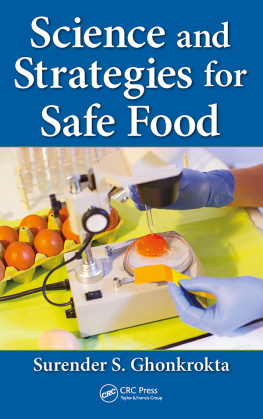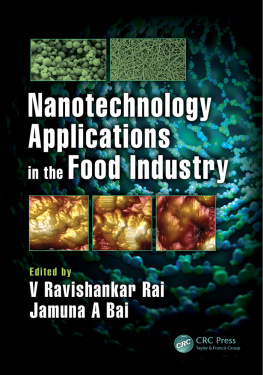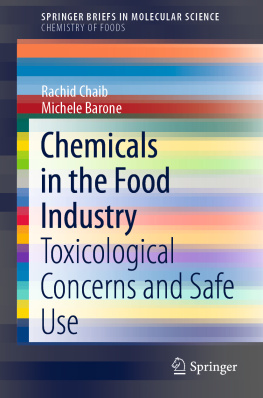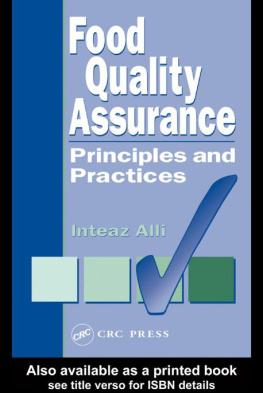
Table of Contents
List of Tables
List of Illustrations
Guide
Pages
Science and Strategies for Safe Food
Science and Strategies for Safe Food
Surender S. Ghonkrokta

CRC Press
Taylor & Francis Group
6000 Broken Sound Parkway NW, Suite 300
Boca Raton, FL 33487-2742
2017 by Taylor & Francis Group, LLC
CRC Press is an imprint of Taylor & Francis Group, an Informa business
No claim to original U.S. Government works
Printed on acid-free paper
International Standard Book Number-13: 978-1-138-71327-7 (Hardback)
This book contains information obtained from authentic and highly regarded sources. Reasonable efforts have been made to publish reliable data and information, but the author and publisher cannot assume responsibility for the validity of all materials or the consequences of their use. The authors and publishers have attempted to trace the copyright holders of all material reproduced in this publication and apologize to copyright holders if permission to publish in this form has not been obtained. If any copyrighted material has not been acknowledged please write and let us know so we may rectify in any future reprint.
Except as permitted under U.S. Copyright Law, no part of this book may be reprinted, reproduced, transmitted, or utilized in any form by any electronic, mechanical, or other means, now known or hereafter invented, including photocopying, microfilming, and recording, or in any information storage or retrieval system, without written permission from the publishers.
For permission to photocopy or use material electronically from this work, please access www.copyright.com (http://www.copyright.com/) or contact the Copyright Clearance Center, Inc. (CCC), 222 Rosewood Drive, Danvers, MA 01923, 978-750-8400. CCC is a not-for-profit organization that provides licenses and registration for a variety of users. For organizations that have been granted a photocopy license by the CCC, a separate system of payment has been arranged.
Trademark Notice: Product or corporate names may be trademarks or registered trademarks, and are used only for identification and explanation without intent to infringe.
Library of Congress Cataloging-in-Publication Data
Names: Ghonkrokta, Surender S., author.
Title: Science and strategies for safe food / Surender S. Ghonkrokta.
Description: Boca Raton : Taylor & Francis, CRC Press, 2017. | Includes bibliographical references and index.
Identifiers: LCCN 2016056411 | ISBN 9781138713277 (hardback : alk. paper)
Subjects: LCSH: Food adulteration and inspection. | Food contamination--Prevention. | Food industry and trade--Quality control. | Food security.
Classification: LCC TX531 .G47 2017 | DDC 338.4/7664--dc23
LC record available at https://lccn.loc.gov/2016056411
Visit the Taylor & Francis Web site at
http://www.taylorandfrancis.com
and the CRC Press Web site at
http://www.crcpress.com
At the outset, I compliment Dr. Ghonkrokta for his venture to bring out an excellent compilation of information on various aspects of food safety in this compact book titled Science and Strategies for Safe Food. The subject of food safety is on one hand so commonplace that almost everyone has something to say about it, but on the other hand it is so vast that volumes can be written on each of its topics. When it comes to policy making, or paying attention to it in our daily lives, no subject gets such fleeting treatment as food safety, despite it being so crucial to our well-being and even that of future generations (due to genotoxic contaminants). At the international level, concerns have been expressed about access to sufficient and nutritious food by millions in developing countries. It has been recognized that unsafe food is no food. Food security has been defined to include safe and nutritious food that meets the dietary needs and food preferences of the population for an active and healthy life. The World Food Summit held in Rome in 1996 set a target of food security for all in an ongoing effort to eradicate hunger in all countries, with an immediate view to reducing the number of undernourished people to half their present level no later than 2015. This goal was reiterated by the Millennium Summit in South Africa in September 2000, the largest gathering of world leaders in history, and the World Summit on Food Security held in Rome in 2009. Significantly, in 1996, it was estimated that about 800 million people, particularly in developing countries, did not have enough food to meet their basic nutritional needs. In 2009, the Declaration of the World Summit on Food Security noted: We are alarmed that the number of people suffering from hunger and poverty now exceeds 1 billion. This is an unacceptable blight on the lives, livelihoods and dignity of one-sixth of the worlds population. The Declaration committed itself to supporting national, regional, and international programs that contribute to improved food safety and animal and plant health, including prevention and control of transboundary animal and plant pests and diseases. It also committed to promoting effective national food safety systems, covering all stages of the food chain and involving all actors, that ensure the compliance of food products with science-based international standards, and that improve food safety and quality for the people, with emphasis on locally available food. The Codex Alimentarius Commission has also prepared the Strategic Plan 20142019 to meet the challenges of emerging food safety issues arising from increased globalization, climate change, shifting population, and so on. It is against this background that I find Dr. Ghonkroktas book to be a timely, relevant, and positive contribution in the direction of assuring safe food for all.
To successfully achieve the global objective of alleviating hunger, a robust regulatory mechanism is necessary, though not sufficient, particularly in developing countries where the hiatus between the reach of the regulator and the large number of actors in the food supply chain is not likely to be bridged soon. This is not to suggest that regulation is the ideal, capable, or desirable mode of ensuring the safety of food available to the consumer at the end of the chain. Experience the world over has shown that voluntary compliance and awareness among food business operators as well as consumers can be the only sustainable strategy to achieve the goal of food safety. India adopted this approach in the year 2006 when the Food Safety and Standards Act (FSSA) was enacted by the Indian Parliament and as a result of which the Food Safety and Standards Authority of India (FSSAI) was established in the year 2008. The old Prevention of Adulteration Act (PFA), 1954, provided for a minimum punishment of three months imprisonment for any food-related offense, including an offense like the sale of substandard and misbranded food. In 2011, the FSSA promulgated more persuasive and voluntary compliance by food business operators and the decriminalization of minor deviations from the regulations that do not make food unsafe. As director of the FSSAI, Dr. Ghonkrokta was a part of the team that ushered India into the new FSSA regime. Being an academic from the field of food technology and a member of the civil service, and having worked in the FSSAI at the crucial juncture of transition from the PFA to the new Act, he is in a unique position to appreciate food safety issues from the perspectives of food science, enforcement, and food business operators. In this book, he has skillfully combined all these perspectives and discussed the tools required to achieve the global mandate for food safety. He has defined the role of actors in the entire food chain and takes us through the entire gamut of issues pertaining to the production and consumption of food by us. The book is a handy reference for regulators and food safety managers in different sectors, from primary producers to processing, transport, retail, and distribution, as well as the food services sector.
Next page







